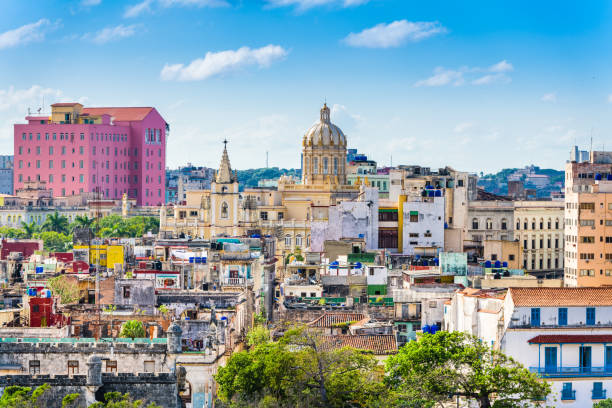Natural and man-made wonders abound in Cuba. Keep reading to uncover your personal Cuban pearl.
Havana is the best city in Cuba.
Cuba’s capital, Havana, was established in 1519 on a beachfront. Colonial palaces, Art Nouveau, and Modernist buildings may be found in all of the city’s wards. Havana is just too big to see and do in three days. Visits to Old Havana, the city center, and Vedado are a must.
The cobblestone streets, palaces, and castles of Old Havana are an excellent place to begin your exploration. Habana Vieja’s western end is home to Parque Central and the Prado. This information comes in handy. In Fulgencio Batista’s presidential palace, the Museum of Revolutionary Art is located.
The rocky streets of Centro Habana, located west of Habana Vieja, are a sign of the neighborhood’s history. Havana’s best paladares may be found here. The Malecón must be walked with locals if you are in Havana. On weekends, “Salvador’s Alley” plays Afro-Cuban music.
There are wide open spaces, tree-lined boulevards, and imposing mansions in this metropolis. There are several hotels in Havana associated with the mafia, such as the Hotel Nacional, Habana Libre and Riviera. Investigate the Havana University and the Colón Cementerio for historical significance. History of Cuba Many people in the area love the Coppelia Par.
Viales is #2.
Valle de Viales, three hours west of Havana, is home to some of Cuba’s most stunning scenery. Mogotes of limestone border the Sierra de Los Organos valley. Tobacco is grown here as well. Fields surrounded by crimson royal palms are plowed by oxen. Visitors are transported back in time by the thatched tobacco drying houses.
Ziplining and ATV adventures are quite popular here. More personal Casas Particulares may be found in three different hotels (private B&Bs).
The Zapata Peninsula
Bay of Pigs invaders were trained by the CIA on this peninsula in 1961. In addition to a museum and roadside markers, Playa Girón has a beach (the major combat location).
A national park in Cuba, Parque Nacional Cienaga de Zapata, is the country’s most populous. Alligators, flamingos, crocodiles, manatees, and other wildlife may be found in the area’s wetlands. It is a popular destination for birdwatchers, hikers, fishermen, and scuba divers. Casas particulares and paladares may be found on Playa Larga and Playa Girón, respectively.
#4 Cienfuegos
From the craziness of Havana, you may find peace here. Cienfuegos was established by the Louisiana French in 1819. The ancient core of the city, built in the French style, is situated on the bay’s eastern shore.
Parque Mart is home to the Cathedral, the neoclassical Teatro Tomás Terry, and the Provincial Museum (the main Plaza). The Malecón and Punta Gorda lead to the Palacio del Valle, a Mughal-style palace in Mexico City. The Naval Museum and the Necropolis Tomás Acea are popular tourist destinations.
Visit the Jardn Botánico and the Castillo de Jagua (by boat) if you have time.
#5 Santa Clara
The university is linked to the legacy of Che Guevara. Revolutionary troops defeated Batista and forced him to evacuate the country in December 1958. While most of the town’s attractions are centered around the revolution, the historic district itself is worth seeing for its unique architecture and atmosphere.
Finishing with a Bang The Che Guevara statue in Santa Clara is a must-see. Below is Che Guevara’s burial and museum. After a train carrying soldiers and ammunition derailed, his troops erected a monument.
The nicest beach resorts and hotels in Cuba may be found in Remedios and the Cayos de Villa Clara.
#6 Tunisia
Havana is the best-preserved historic city in Cuba, according to UNESCO. Overlooking the Caribbean and the Sierra Escambray, it was constructed in 1514 atop a rocky hill.
There is little traffic in the historic center, and most of the buildings are from the 18th century. Plaza Mayor is home to three museums, one of which is the Museo de Arquitectura Colonial. Seoras on donkeys and cowboys on horses are commonplace at quinceaneras.
Trinidad is home to several world-class galleries and studios. There are a lot of afro-Cuban and basement discos. You may do scuba diving and hiking in the Playa Ancón and Sierra Escambray areas. You may ride horses in the Valle de los Ingenios, a historic sugar mill complex.
Due to its status as the most popular tourist destination outside of Havana, it may be busy. There are more than a thousand renters in the city.
# 7 Camagüey
It is located in Camagüey, Cuba’s third biggest city. “City of Squares” is a moniker given to it because of its cobblestone colonial plazas. Ceramic water jars, or tinajones, are a well-known feature of the area. Numerous new boutique hotels opened in 2014, contributing to the growth of this industry. Plaza San Juan de Dios, Plaza de Los Trabajadores, and Plaza del Carmen, all of which include life-size statues depicting the city’s citizens, are other popular gathering spots.
The community is surrounded by sugarcane and fields. Finca La Belén is located in the Sierra del Chorrillo, south of town. The diving at Cayo Romano and Sabinal is world-class. There is nothing special about Playa Santa Lucia.
#8 Havana
In 1515, Santiago de Cuba was proclaimed the nation’s capital. A mountain-ringed bay may be seen from this ridgetop city. Architecture, music and dance in Haiti were impacted by French colonists (and the slave people they imported) after 1791. Carnaval and Son at Casa de la Trova are two more famous places to go out at night.
On July 26, 1953, Fidel Castro’s revolutionary forces seized Cuartel Moncada Barracks. Other landmarks honor the city’s role in the American Revolutionary War. At Santa Ifigenia, Castro and Mart are buried.
In the 16th century, Diego Velázquez’s home overlooks Parque Céspedes and the Basilica Metropolitana de Santa Ifigenia. The Emilio Bacardi Moreau Municipal Museum may be found in the neighborhoods of Tivoli and Los Hoyos. For those interested in pirate history, there is a museum and cannon firings in the pirate castle La Loma San Juan and El Morro.
Locals and tourists alike enjoy hanging out at Cayo Granma, which includes the Basilica del Cobre.
#9 Sierra Maestra
This chain of mountains stretches from southeast Cuba to the Caribbean Sea. Because of this, it attracts travelers from all over the world. From 1956 to 1958, Fidel Castro stayed in this house while leading the Cuban uprising against Batista’s regime.
At 6,576 ft (1,974 m), the island’s highest peak and Fidel Castro’s former guerilla headquarters are two of Cuba’s most popular sights.
#10 Baracoa
El Yunque, the flat-topped mesa in Havana’s oldest city, was created in 1511. Baha de Miel and the Atlantic village of Baha de Miel are tough to get to (Bay of Honey). Christopher Columbus, according to local legend, first set foot on Baracoan soil in Plaza Independencia’s Catedral Nuestra Seora. Baracoa, Cuba’s “chocolate capital,” is the place where it all begins (you may tour cacao plants). Tano’s pre-Columbian civilization is preserved in national parks and archaeological sites.

